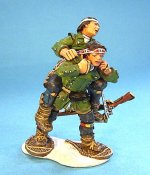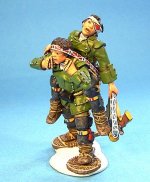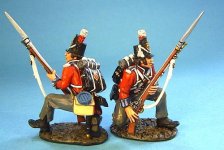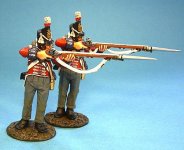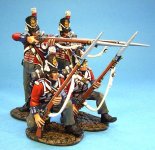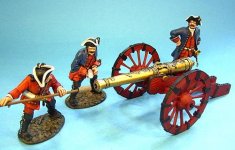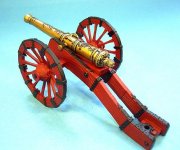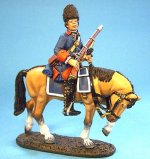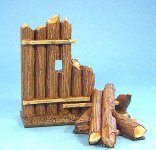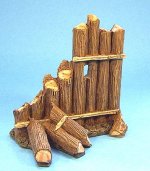New John Jenkins releases for October.
Hello all
Here is the latest information on the new releases for October. We hope you will join John and us in Chicago on Saturday 27th, @ 2.00pm where as usual he will be announcing his new series. All new sets for October should be with him at the show. He will be at Chicago from Thursday 25th until Monday 29th September..
I think these new releases will please everyone and have certainly pleased me, especially the French Artillery and the Royal Scots.
I hope you enjoy these new releases.
Mike and Myszka
Sierra Toy Soldier Company
BATTLE ON SNOWSHOES
Sleds were especially useful for evacuating the wounded after a battle.
When the sleds were unavailable another method which was commonly used by the Rangers and was inspired by an Indian technique, was the use of a “tumpline”.
The Indian method was to carry the injured man by piggy-back by having him sit on a pack or blanket tied with a tumpline. The wide part of the line lying across the carrier’s forehead.
The Iroquois were known to carry their wounded in this manner “hundreds of leagues”.
SRR-06 - “HE AINT HEAVY, HE’S MY BROTHER”2 Figures retreating - (1pc) Limited Edition 500
Retail us$39
THE BATTLE OF CHIPPEWA July 5th 1814
The first British set for the War of 1812 collection appears this month.
The Royal Scots originally known as the Royal Regiment of Foot, it was the oldest infantry regiment of the line in the British army.
Originally raised in 1633, in February 1812 the regiment was re-titled the 1st Regiment of Foot (Royal Scots)
The First Battalion was sent to Quebec with the outbreak of the War of 1812.
The third Battalion fought in the Penninsula War and was later part of Picton’s Division at the Battle of Waterloo.
These figures will be suitable for Waterloo displays
Their nickname as “Pontius Pilate’s Bodyguard”, originated from a Seventeenth Century boasting contest with the French Regiment of Picardy, who boasted that prior to the Resurrection, Christ’s Tomb was guarded by the French Regiment.
Both claims are untrue.
BCH-01
1st Regiment of Foot (Royal Scots) - 2 Kneeling Figures (2 pcs)
Limited Edition 500
Retail us$56
BCH-02
1st Regiment of Foot (Royal Scots)
2 Figures Firing (2pcs)
Limited Edition 500
Retail us$56
BATTLE OF THE PLAINS OF ABRAHAM
QFA-01 - French Artillery Crew, Loading (3pcs)
Limited Edition 750
Retail us$84
Although it is well documented that the British had two 6lb Battalion guns at the Battle of the Plains of Abraham, it is uncertain as to how many artillery pieces were present on the French side. An artillery officer named Montbelliard, is reported to have mentioned having “detached” two guns from the left to the right and later refers to the guns on the left, which would suggest a minimum of four. Although another artillery officer named Foligne says there were five. However Townshend refers to only one.
The greatest influence on American artillery history came from the French. They were to eventually adopt the French Gribeauval artillery system that first appeared towards the end of this century.
The main artillery pieces used by the French during this period were developed in the 1730’s by a General Valliere. He was to standardize French gun calibers and specified set lengths, proportions and weights for each gun that beforehand had depended upon the casting foundry’s discretion.
The result was a series of handsome guns as well as a standardized series of models. All Valliere guns were brass, and were long and slender.
Their decoration was to be functional as well as ornamental.
Each caliber usually had a different design of the breech faces, so that the gunner could recognize the size of the piece simply by a glance at the breech. The 8pdr had a monkey’s head.
The handles or “dolphins” used for mounting and dismounting the piece were actually sculpted as dolphins, as well as a series of decorative and informative low relief sculptures that ran from the muzzle to the breech.
These designs consisted of a scroll bearing the name of the piece itself, such as “La Brillante” or “La Mutine”.
Behind this was another scroll bearing the latin motto “Ultima Ratio Regum” (The Last Argument of Kings)
For many guns of the Valliere system the next scroll bore the name of Louis Auguste de Bouron, Duc de Maine, who was Grand Master of French artillery.
Then came the Royal arms surmounted by a sunburst and the motto “Nec Pluribus Impar” (Not Unequal to Many) This was the device and motto of Louis XIV.
There was however no uniformity in the wagons that supported the guns. The only unifying characteristics of Valliere carriages was their colour. All were painted a deep red.
QFGUN-01
French 8-pdr Valliere Gun, (3 pcs)
Limited Edition 750
Retail us$39
The Corps de Cavalerie, 1759-1760
This cavalry unit was the first mounted unit to be formed in Canada, and was one of the few cavalry units that took part in the French and Indian war. It existed from May 1759 to September 1760.
It was formed from 200 Canadian volunteers and five French Officers. The unit acted primarily as scouts or couriers for the army during the final campaigns in New France.
There were reported 200 Corps de Cavalerie at The Battle of The Plains of Abraham, under the command of Brig. Gen. Bougainville’s flying column, which was approaching the battle late in the day from Cap Rouge in the south.
Bougainville advanced the cavalry far enough for them to skirmish with Howe’s light infantry, which was positioned to cover the British army’s rear.
Once Bougainville realized that his arrival was too late and the battle was already lost, he withdrew his cavalry and his infantry even before they were to become engaged.
This set presents a trooper of the French Corps de Cavalerie and is wearing the single breasted blue cavalry coat with red collar and cuffs, and a bearskin cap.
QFCAV-01
French Corps de Cavalerie
(2pcs)
Limited Edition 750
Retail us$59
Compagnies Franches de la Marine
Another set of marines to add variety to the French firing line. This set presents the marine without his grey/white “justacorp” overcoat.
The infantry equipment is worn directly over the blue regimental “veste”, which made a comfortable and neat summer uniform.
QFM-02
French Marines in summer uniform, Firing 2
(2pcs) L
Limited Edition 750
Retail us$56
THE RAID ON ST. FRANCIS
Since we have the first French artillery set this month. For those who like to mix their sets with different collections, this month we have a pair of artillery damaged Stockade walls!
The two pieces together make up the same size as the STWALL section
STDAMAGE
RAID ON ST. FRANCIS, STOCKADE
2 Damaged Wall sections
Not Limited
Retail us$16 (2 pcs)
Dimensions, 61/4” Length.
Well I hope you enjoyed them as much as I did.
Best regards see you in Chicago.
.
Mike and Myszka
Sierra Toy Soldier Company
Hello all
Here is the latest information on the new releases for October. We hope you will join John and us in Chicago on Saturday 27th, @ 2.00pm where as usual he will be announcing his new series. All new sets for October should be with him at the show. He will be at Chicago from Thursday 25th until Monday 29th September..
I think these new releases will please everyone and have certainly pleased me, especially the French Artillery and the Royal Scots.
I hope you enjoy these new releases.
Mike and Myszka
Sierra Toy Soldier Company
BATTLE ON SNOWSHOES
Sleds were especially useful for evacuating the wounded after a battle.
When the sleds were unavailable another method which was commonly used by the Rangers and was inspired by an Indian technique, was the use of a “tumpline”.
The Indian method was to carry the injured man by piggy-back by having him sit on a pack or blanket tied with a tumpline. The wide part of the line lying across the carrier’s forehead.
The Iroquois were known to carry their wounded in this manner “hundreds of leagues”.
SRR-06 - “HE AINT HEAVY, HE’S MY BROTHER”2 Figures retreating - (1pc) Limited Edition 500
Retail us$39
THE BATTLE OF CHIPPEWA July 5th 1814
The first British set for the War of 1812 collection appears this month.
The Royal Scots originally known as the Royal Regiment of Foot, it was the oldest infantry regiment of the line in the British army.
Originally raised in 1633, in February 1812 the regiment was re-titled the 1st Regiment of Foot (Royal Scots)
The First Battalion was sent to Quebec with the outbreak of the War of 1812.
The third Battalion fought in the Penninsula War and was later part of Picton’s Division at the Battle of Waterloo.
These figures will be suitable for Waterloo displays
Their nickname as “Pontius Pilate’s Bodyguard”, originated from a Seventeenth Century boasting contest with the French Regiment of Picardy, who boasted that prior to the Resurrection, Christ’s Tomb was guarded by the French Regiment.
Both claims are untrue.
BCH-01
1st Regiment of Foot (Royal Scots) - 2 Kneeling Figures (2 pcs)
Limited Edition 500
Retail us$56
BCH-02
1st Regiment of Foot (Royal Scots)
2 Figures Firing (2pcs)
Limited Edition 500
Retail us$56
BATTLE OF THE PLAINS OF ABRAHAM
QFA-01 - French Artillery Crew, Loading (3pcs)
Limited Edition 750
Retail us$84
Although it is well documented that the British had two 6lb Battalion guns at the Battle of the Plains of Abraham, it is uncertain as to how many artillery pieces were present on the French side. An artillery officer named Montbelliard, is reported to have mentioned having “detached” two guns from the left to the right and later refers to the guns on the left, which would suggest a minimum of four. Although another artillery officer named Foligne says there were five. However Townshend refers to only one.
The greatest influence on American artillery history came from the French. They were to eventually adopt the French Gribeauval artillery system that first appeared towards the end of this century.
The main artillery pieces used by the French during this period were developed in the 1730’s by a General Valliere. He was to standardize French gun calibers and specified set lengths, proportions and weights for each gun that beforehand had depended upon the casting foundry’s discretion.
The result was a series of handsome guns as well as a standardized series of models. All Valliere guns were brass, and were long and slender.
Their decoration was to be functional as well as ornamental.
Each caliber usually had a different design of the breech faces, so that the gunner could recognize the size of the piece simply by a glance at the breech. The 8pdr had a monkey’s head.
The handles or “dolphins” used for mounting and dismounting the piece were actually sculpted as dolphins, as well as a series of decorative and informative low relief sculptures that ran from the muzzle to the breech.
These designs consisted of a scroll bearing the name of the piece itself, such as “La Brillante” or “La Mutine”.
Behind this was another scroll bearing the latin motto “Ultima Ratio Regum” (The Last Argument of Kings)
For many guns of the Valliere system the next scroll bore the name of Louis Auguste de Bouron, Duc de Maine, who was Grand Master of French artillery.
Then came the Royal arms surmounted by a sunburst and the motto “Nec Pluribus Impar” (Not Unequal to Many) This was the device and motto of Louis XIV.
There was however no uniformity in the wagons that supported the guns. The only unifying characteristics of Valliere carriages was their colour. All were painted a deep red.
QFGUN-01
French 8-pdr Valliere Gun, (3 pcs)
Limited Edition 750
Retail us$39
The Corps de Cavalerie, 1759-1760
This cavalry unit was the first mounted unit to be formed in Canada, and was one of the few cavalry units that took part in the French and Indian war. It existed from May 1759 to September 1760.
It was formed from 200 Canadian volunteers and five French Officers. The unit acted primarily as scouts or couriers for the army during the final campaigns in New France.
There were reported 200 Corps de Cavalerie at The Battle of The Plains of Abraham, under the command of Brig. Gen. Bougainville’s flying column, which was approaching the battle late in the day from Cap Rouge in the south.
Bougainville advanced the cavalry far enough for them to skirmish with Howe’s light infantry, which was positioned to cover the British army’s rear.
Once Bougainville realized that his arrival was too late and the battle was already lost, he withdrew his cavalry and his infantry even before they were to become engaged.
This set presents a trooper of the French Corps de Cavalerie and is wearing the single breasted blue cavalry coat with red collar and cuffs, and a bearskin cap.
QFCAV-01
French Corps de Cavalerie
(2pcs)
Limited Edition 750
Retail us$59
Compagnies Franches de la Marine
Another set of marines to add variety to the French firing line. This set presents the marine without his grey/white “justacorp” overcoat.
The infantry equipment is worn directly over the blue regimental “veste”, which made a comfortable and neat summer uniform.
QFM-02
French Marines in summer uniform, Firing 2
(2pcs) L
Limited Edition 750
Retail us$56
THE RAID ON ST. FRANCIS
Since we have the first French artillery set this month. For those who like to mix their sets with different collections, this month we have a pair of artillery damaged Stockade walls!
The two pieces together make up the same size as the STWALL section
STDAMAGE
RAID ON ST. FRANCIS, STOCKADE
2 Damaged Wall sections
Not Limited
Retail us$16 (2 pcs)
Dimensions, 61/4” Length.
Well I hope you enjoyed them as much as I did.
Best regards see you in Chicago.
.
Mike and Myszka
Sierra Toy Soldier Company


